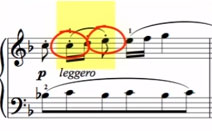Welcome back to our multi-part series on the Burgmüller Studies. These pieces are really great for piano students at a fairly elementary level yet provide some gorgeous music. In the first lesson we covered La Candeur (Frankness) and last time we covered L’Arabesque. Today we are going to talk about how to approach La Pastorale – which is a great piece to introduce using the pedal to students.
If you followed my past lessons on Burgmüller you might notice how different each of these pieces sound. It’s a great way to introduce students to many different types of music that are both easily accessible and unique from one another.
The key to mastering this particular piece is a lot like the first lesson we covered which is to use the weight of your arms to maintain a smooth legato with rises and falls of dynamics in each phrase. This piece has the added challenge of a degree of complexity in the left hand. As opposed to the whole notes in La Candeur, you have a pattern of repeated chords:

I always recommend practicing your music without the pedal first in order to achieve a smooth legato. The same principle remains true here. Once you feel confident, you should add the pedal to add to the smoothness.
After you’ve practiced both hands independently try putting them together but still practicing without the pedal. You want to achieve a smooth legato in both hands without using the pedal as a crutch. Once you can play smoothly with confidence, go back and add the pedal.
Why is it so important to play notes legato if you’re going to add the pedal anyway?
This is a likely question you hear from intelligent students. Wouldn’t the pedal make everything smooth anyway? Not necessarily. You must capture all the notes of the first chord in each group whenever engaging the pedal. If you miss any of the notes on the pedal, you will lose the legato. By playing the chords long, you will ensure that all the notes are down when you press the pedal.
In the next section you will not need to use the pedal but you will face a different set of challenges. You have repeated notes in the left hand and a different rhythm to deal with in the right hand:

Make sure you play these notes legato. Not just in the right hand but the left hand as well. Repeated notes present a unique challenge. How can you play these notes legato? The secret is changing the fingers you use for each note. This way you can have one finger coming going up while another finger is going down. This technique will create a sense of connectivity in the notes and create a beautiful line. Try this section with this technique and see if you can tell the difference:

Notice 4-3-2 on these B flats. You’ll notice the right hand has the same technique:

Notice the 2-3-4 listed on those notes.
You’ll see these numbers over repeated notes quite a bit in this piece. The secret is to change fingers for repeated notes so you can achieve a smooth sound.
Thanks again for joining me Robert Estrin here at Living Pianos. I hope this has been helpful for you and make sure to stay tuned to our future episodes in the Burgmüller studies on piano. If you have any questions about this topic or any topic at all please contact us directly: Info@LivingPianos.com (949) 244-3729.























